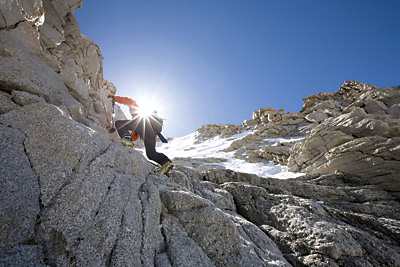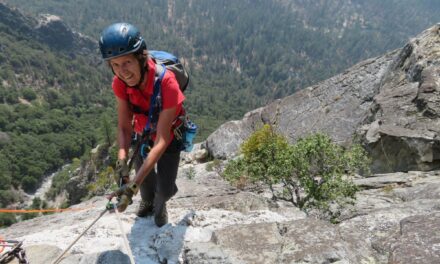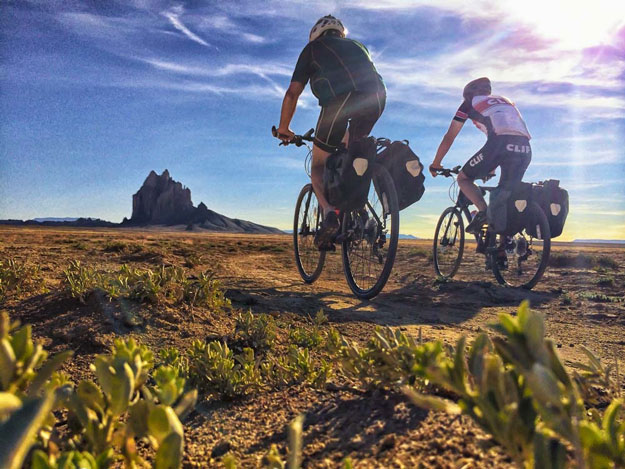- Tahoe’s Nevada Beach Tops the List of Hard-to-Book Campgrounds - 07/17/2024
- Cannabis Watershed Protection Program Cleans Up Illegal Grow Sites - 07/10/2024
- French Fire - 07/05/2024

Sports Photography Tips from Sierra sharp shooter Christian Pondella
By Seth Lightcap • Photos by Christian Pondella
Skier Chris Davenport climbs and skis the Mountaineer’s Route on Mt. Whitney, spring 2008.
Do you ever wish your camera had an auto setting labeled ‘Amazing Action Shot’?
You’re not alone.
Despite how easy it is to flip your camera to the ‘sports’ setting and hit the shutter button as your buddy blows past you skiing, biking, or paddling, it’s surprisingly hard to come away from the moment with a stellar image of the action. Whether the shot is well–framed but blurry or focused but missing half a head, there are a lot of ways a one-chance shot can be flubbed.
Sure you can blame a little bit of your inability on a slow point and shoot camera, but the reality is, catching a striking action shot takes a lot more skill than just aiming and firing from the hip.
Mammoth local and Red Bull USA photographer Christian Pondella knows a little something about what it takes to fill a memory card with sick pics. Having published work in just about every major ski publication, as well as, Outside, Men’s Journal, Sports Illustrated and GQ, Pondella has built a career around producing intimate images of adventure sports’ best athletes basking in their glory.
As an exclusive treat for all of you aspiring action photographers, Adventure Sports Journal caught up with Pondella to pick his brain on the forethought and technique he applies to every jaw-dropping frame he shoots. If you’ve ever wondered how shots like Pondella’s look so good in the magazines, read on for a few tips and tricks to help bring your shutter skills up to speed with the pros.
What are the basic ingredients of a great action shot?
The best action sports photos express the dynamics of an experience or event using great light and a cool subject.
What kind of light do you look for?
My favorite photos combine light and shadows. I avoid shooting in direct sunlight if possible. Generally you’re looking for the sun off to one side, but still illuminating your subject. Don’t be afraid to break the rules though. I’ll often include the sun in my photos.
How do you capture dynamic movement?
The best way to make your photos dynamic is to catch your subject in a good position. If you’re serious about the shot, talk to your subject and see where they are going to go. Set it up so that you are framed and focused on the spot you think they are going to look best along their route.
What if the action is not overly impressive?
Change the focus of your intended image. Many times I will frame a beautiful landscape shot and try to place the subdued action perfectly within it.
What is your favorite size lens?
I like to get close to the subject so I use wide angle lenses a lot. Getting close gives you a more intimate feeling of the subject and what’s going on.
What are your sunny day camera settings for action shots?
If your shooting sports it’s best to learn how to configure your camera manually. Choose the manual or shutter speed priority setting; set the ISO at 100 or 200, shutter speed between 640-1000, and aperture at F5.6 or F8.
What angles do you recommend for ski/snowboard photos?
For snow sports shots I like to be on the slope with the skier right next to me or up slope looking down at the skier. From those two angles you can show the steepness of the slope. A lot of amateurs shoot straight up slope from below and it makes everything look flat.
Where do you keep your camera while you’re skiing on a photo shoot?
I usually keep my camera in my backpack and pull it out to set up a shot. If the line is really steep and I don’t want to take my pack off I’ll just slip it over my neck and into my jacket.
How do you dry snowy equipment in the field?
The best thing I’ve found to safely dry wet cameras and lenses is a leather chamois from the auto parts store. They are better than a goggle cloth because there so absorbent. I cut them up into small squares to take with me.
Any thoughts on winter camping with camera equipment?
Be cautious with your equipment going through drastic temperature differences. When you go warm to cold or cold to warm that’s when your equipment will fog up. If I’m winter camping I’ll leave my camera in the vestibule and just take the batteries inside the tent.
Any last advice for successful sports shooting?
Whenever you can, try to gain a vantage point or perspective where you can shoot the action from the same level it’s happening.
To see more of Pondella’s photo prowess visit www.christianpondella.com.













